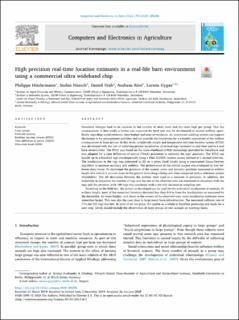Please use this identifier to cite or link to this item:
https://doi.org/10.21256/zhaw-19494Full metadata record
| DC Field | Value | Language |
|---|---|---|
| dc.contributor.author | Hindermann, Philippe | - |
| dc.contributor.author | Nüesch, Stefan | - |
| dc.contributor.author | Früh, Daniel | - |
| dc.contributor.author | Rüst, Andreas | - |
| dc.contributor.author | Gygax, Lorenz | - |
| dc.date.accessioned | 2020-02-19T14:52:19Z | - |
| dc.date.available | 2020-02-19T14:52:19Z | - |
| dc.date.issued | 2020 | - |
| dc.identifier.issn | 0168-1699 | de_CH |
| dc.identifier.issn | 1872-7107 | de_CH |
| dc.identifier.uri | https://digitalcollection.zhaw.ch/handle/11475/19494 | - |
| dc.description.abstract | Structural changes lead to an increase in the number of dairy cows and dry sows kept per group. This has consequences in how easily a farmer can supervise his herd and may be detrimental to animal welfare, specifically regarding social relations, time budget and area of residence. An automated tracking system can support the farmer in his management activities and can provide the foundation for a scientific assessment of the welfare consequences of large groups. In this study, a relatively simple and inexpensive real time location system (RTLS) was developed with the aim of achieving precise localization of several tags (animals) in real time and in a real barn environment. The RTLS was based on the ultra-wideband (UWB) technology provided by DecaWave and was adapted for a time difference of arrival (TDoA) procedure to estimate the tags’ positions. The RTLS can handle up to a hundred tags simultaneously using a Pure ALOHA random access method at 1-second intervals. The localization of the tags was estimated in 2D on a given fixed height using a constrained Gauss-Newton algorithm to increase accuracy and stability. The performance of the overall system was evaluated in two different dairy barns. To determine the precision of the system, static and dynamic positions measured at withers height of a cow (1.5 m) and closer to the ground mimicking a lying cow were compared with a reference system (theodolite). The 2D deviations between the systems were used as a measure of precision. In addition, the scalability in respect to the number of tags and the size of the observed area was examined in situations with ten tags and the situation with 100 tags was simulated with a ten-fold increase in sampling rate. According to the field test, the system as developed can be used for the individual localization of animals. At withers height, most of the measured locations deviated less than 0.5 m from the localizations as measured by the theodolite. At lower heights, and closer to the corners of the observed area, some localization estimates were somewhat larger. This was also the case close to large metal barn infrastructure. The measured collision rate of 11% for 100 tags was low. In spite of its low price, the system as a whole is therefore promising and ready for a next step, which should include the observation of large groups of real animals on working farms. | de_CH |
| dc.language.iso | en | de_CH |
| dc.publisher | Elsevier | de_CH |
| dc.relation.ispartof | Computers and Electronics in Agriculture | de_CH |
| dc.rights | http://creativecommons.org/licenses/by-nd/4.0/ | de_CH |
| dc.subject | Precision Farming | de_CH |
| dc.subject | Realtime location systems (RTLS) | de_CH |
| dc.subject | Time difference of arrival (TDOA) | de_CH |
| dc.subject | Ultra-wide band (UWB) | de_CH |
| dc.subject.ddc | 004: Informatik | de_CH |
| dc.subject.ddc | 630: Landwirtschaft | de_CH |
| dc.title | High precision real-time location estimates in a real-life barn environment using a commercial ultra wideband chip | de_CH |
| dc.type | Beitrag in wissenschaftlicher Zeitschrift | de_CH |
| dcterms.type | Text | de_CH |
| zhaw.departement | School of Engineering | de_CH |
| zhaw.organisationalunit | Institute of Signal Processing and Wireless Communications (ISC) | de_CH |
| zhaw.organisationalunit | Institute of Embedded Systems (InES) | de_CH |
| dc.identifier.doi | 10.1016/j.compag.2020.105250 | de_CH |
| dc.identifier.doi | 10.21256/zhaw-19494 | - |
| zhaw.funding.eu | No | de_CH |
| zhaw.originated.zhaw | Yes | de_CH |
| zhaw.publication.status | publishedVersion | de_CH |
| zhaw.volume | 170 | de_CH |
| zhaw.publication.review | Peer review (Publikation) | de_CH |
| zhaw.webfeed | Wireless Communication | de_CH |
| zhaw.author.additional | No | de_CH |
| Appears in collections: | Publikationen School of Engineering | |
Files in This Item:
| File | Description | Size | Format | |
|---|---|---|---|---|
| 2020_Rüst_ComputersAndElectronicsInAgriculture_Hindermann.pdf | 2.38 MB | Adobe PDF |  View/Open |
Show simple item record
Hindermann, P., Nüesch, S., Früh, D., Rüst, A., & Gygax, L. (2020). High precision real-time location estimates in a real-life barn environment using a commercial ultra wideband chip. Computers and Electronics in Agriculture, 170. https://doi.org/10.1016/j.compag.2020.105250
Hindermann, P. et al. (2020) ‘High precision real-time location estimates in a real-life barn environment using a commercial ultra wideband chip’, Computers and Electronics in Agriculture, 170. Available at: https://doi.org/10.1016/j.compag.2020.105250.
P. Hindermann, S. Nüesch, D. Früh, A. Rüst, and L. Gygax, “High precision real-time location estimates in a real-life barn environment using a commercial ultra wideband chip,” Computers and Electronics in Agriculture, vol. 170, 2020, doi: 10.1016/j.compag.2020.105250.
HINDERMANN, Philippe, Stefan NÜESCH, Daniel FRÜH, Andreas RÜST und Lorenz GYGAX, 2020. High precision real-time location estimates in a real-life barn environment using a commercial ultra wideband chip. Computers and Electronics in Agriculture. 2020. Bd. 170. DOI 10.1016/j.compag.2020.105250
Hindermann, Philippe, Stefan Nüesch, Daniel Früh, Andreas Rüst, and Lorenz Gygax. 2020. “High Precision Real-Time Location Estimates in a Real-Life Barn Environment Using a Commercial Ultra Wideband Chip.” Computers and Electronics in Agriculture 170. https://doi.org/10.1016/j.compag.2020.105250.
Hindermann, Philippe, et al. “High Precision Real-Time Location Estimates in a Real-Life Barn Environment Using a Commercial Ultra Wideband Chip.” Computers and Electronics in Agriculture, vol. 170, 2020, https://doi.org/10.1016/j.compag.2020.105250.
Items in DSpace are protected by copyright, with all rights reserved, unless otherwise indicated.